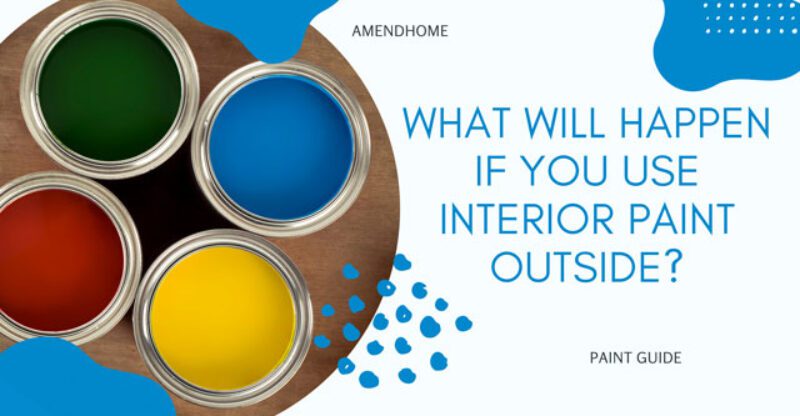What will happen if you Use Interior Paint Outside?
Interior paint and exterior paint are not interchangeable. They are designed and formulated for different environments and purposes.
Using interior paint outside can lead to a range of problems that can be both costly and time-consuming to fix. In this blog post, we will explore the potential consequences of using interior paint outside, and why it’s important to use the right paint for the right job.
Why You Should Not Use Interior Paint Outside?
Using interior paint for an exterior project can lead to a variety of issues, including:
Fading and Discoloration
Interior paint is not designed to withstand the elements, and exposure to sunlight, wind, rain, and other weather conditions can cause it to fade and discolor quickly.
The pigments used in interior paint are not as resistant to UV light as those used in exterior paint, which are formulated to maintain their color and appearance over time.
As a result, using interior paint outside can lead to unsightly and uneven fading, which can detract from the aesthetic appeal of your property.
Peeling and Blistering
Another common problem that can arise when using interior paint outside is peeling and blistering. Exterior paint is formulated to expand and contract with temperature changes, which helps it adhere to surfaces more effectively.
Interior paint, on the other hand, lacks this flexibility and can easily crack and peel when exposed to the elements.
As a result, using interior paint on exterior surfaces can lead to unsightly peeling and blistering, which can compromise the integrity of the underlying surface and require extensive repairs.
Mildew and Mold Growth
Exterior paint is formulated with special additives that make it resistant to mildew and mold growth, which can thrive in damp and humid environments.
Interior paint, on the other hand, lacks these additives and is more susceptible to fungal growth. When used outside, interior paint can quickly become a breeding ground for mildew and mold, which can cause health problems and compromise the structural integrity of your property.
Lower Durability and Lifespan
The lifespan and durability of interior paint are significantly lower than those of exterior paint. Interior paint is designed to withstand relatively mild wear and tear, such as scuffs, scratches, and occasional cleaning.
The exterior paint, on the other hand, is formulated to withstand a range of environmental stresses, including UV radiation, moisture, temperature changes, and abrasion.
Using interior paint outside can lead to premature wear and tear, which can compromise the appearance and longevity of your property.
The Dangers of Using Interior Paint Outside
Using interior paint outside can pose health and environmental hazards, as well as have long-term effects on the durability of your paint and the protection of your home’s exterior.
Health Hazards Associated with Using Interior Paint Outside
Interior paints have lower levels of volatile organic compounds (VOCs) than exterior paints, which can be harmful to human health. VOCs can cause headaches, dizziness, and respiratory issues, and prolonged exposure can lead to more severe health problems.
Environmental Hazards Associated with Using Interior Paint Outside
- Water Pollution: Interior paint is not designed to withstand exposure to rain and other moisture sources. When used outside, the paint can wash off and contaminate nearby water sources, leading to water pollution.
- Landfill waste: If the paint does not properly adhere to the exterior surface, it may need to be scraped off and disposed of, leading to increased landfill waste.
Choosing the Right Paint for Your Outdoor Project
Choosing the right paint for your outdoor project is critical to ensuring a long-lasting, high-quality finish. Here are some things to consider when selecting exterior paint:
Types of Exterior Paint
- Latex Paint: This is the most common type of exterior paint and is easy to clean and maintain. Latex paint dries quickly, is resistant to fading and cracking, and is environmentally friendly.
- Oil-Based Paint: Oil-based paint provides a more durable finish than latex paint and is ideal for high-traffic areas. However, it takes longer to dry, is more difficult to clean up, and emits more VOCs than latex paint.
- Specialty Paint: There are various specialty paints available, including waterproof coatings, elastomeric coatings, and textured coatings. These paints are formulated for specific applications, such as protecting against water damage or hiding imperfections on the surface.
Factors to Consider when Choosing Exterior Paint
- Climate: Consider the climate of your area and the weather elements your home is exposed to. Choose a paint that is formulated to withstand the climate in your region.
- Surface Type: Different surfaces require different types of paint. For example, stucco requires painting that can fill up small cracks and gaps, while wood requires paint that can penetrate the surface and resist moisture.
- Color: Darker colors absorb more heat than lighter colors, which can cause the paint to fade and deteriorate faster. Consider your paint’s color when choosing the type of paint to use.
Tips for Selecting the Right Paint for your Outdoor Project
- Read the Label: Make sure to read the label carefully to ensure that the paint is suitable for your project.
- Choose a Reputable Brand: Choose a paint from a reputable brand that has a proven track record of quality and durability.
- Consult with a Professional: If you’re unsure about which type of paint to use, consult with a professional painter or paint supplier for guidance.
Conclusion
To Use interior paint outside is a recipe for disaster. You must choose the right type of paint for your exterior painting project if you want the best results.
Exterior paint is designed to withstand the rigors of the environment, while interior paint is designed for indoor use only.
Using the right paint for the right job, you can protect your investment and enjoy a long-lasting finish for years.
FAQs
Interior paint can last for up to six months on exterior surfaces before it begins to deteriorate. However, this can vary depending on factors such as weather conditions, surface preparation, and the quality of the paint used.
Using a paint scraper, sandpaper, or a pressure washer will help you remove interior paint from exterior surfaces. However, be careful not to damage the surface beneath the paint, and be sure to follow the manufacturer’s instructions for the paint removal method you choose.
Yes, there is a significant difference between interior and exterior paint. Exterior paint is formulated to withstand harsh weather conditions and provide long-lasting protection to the surfaces it’s applied on, while interior paint is designed for use in indoor environments.



